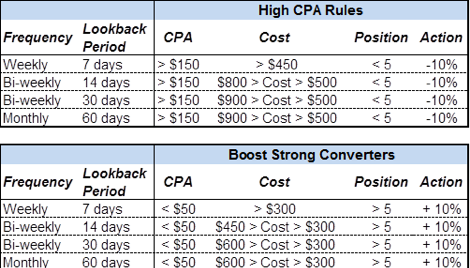
I’d venture to guess that most PPC managers share the same basic set of bid rules. It makes perfect sense, as most of us have the same general goal for bidding: find the perfect sweet spot between CPC and volume, usually driven by position. If CPA is high and position is high, drop bids. If CPA low and position is low, boost bids. Logical, right?
Typically when I’ve audited or adopted accounts, I tend to see the same basic bidding formula. Find keywords that are x-percent over goal for 30 days and drop bids by x%. These rules are set to run either on the same day of the week, once a week, or on the 15th & 30th of each month. Again, logical! We want to make sure that keywords are frequently evaluated.
But think about what’s flawed about this style of methodical bidding. Instead of looking at 30 days of new data each time, the “average” bid rule will be looking at seven days of new data from the last adjustment adjusted, and 23 days of old data. Chances are that same rule will hit that same keyword at least twice, if not three times. Instead of dropping your bids by 10% as your rule is designed to do, you may wind up dropping bids by 19-27%. At that point the “upward” facing bid rules will kick in and boost bids by 10% every week.
Your bids for your top-volume keywords will wind up in a vicious superball cycle, rather than making small adjustments as you’d expected or planned on.
The other major flaw in the methodical/repeated bidding cycle is that your rules will miss low-volume keywords keywords that convert once or twice over the course of a month/quarter/year. These keywords could major successes or money pits in the long term, but your bid rules will never connect with them.
Certainly there are less manual solutions; Acquisio’s Bid Algorithms are an example, and most other software platforms have something similar available. However, some account managers (like me) are control freaks. I like to see what’s going on in my accounts, have control over everything I can and like to see the bid optimizations before they’re executed. Instead of an algorithm or basing rules based on the last 30-whatever days of data, I’d recommend creating a phased bid approach to ensure everything is captured over time.
The strategy is to create high frequency bid rules to make sure high-spending keywords are reviewed frequently, while creating lower frequency rules to review lower spenders less frequency. The trick in this strategy is to put in a spend cap for lower frequency rules so they don’t wind up just repeating or duplicating efforts of the initial rules.
I put together a table below for a hypothetical account or campaign with a $50 CPA goal to show what I mean.

Now, obviously this strategy is not perfect as there will still be some overlap, but this is the best strategy I’ve found to date to manage basic bid rules without duplication or repetition.
What are some of your favorite “automated” bidding tips or tricks?



